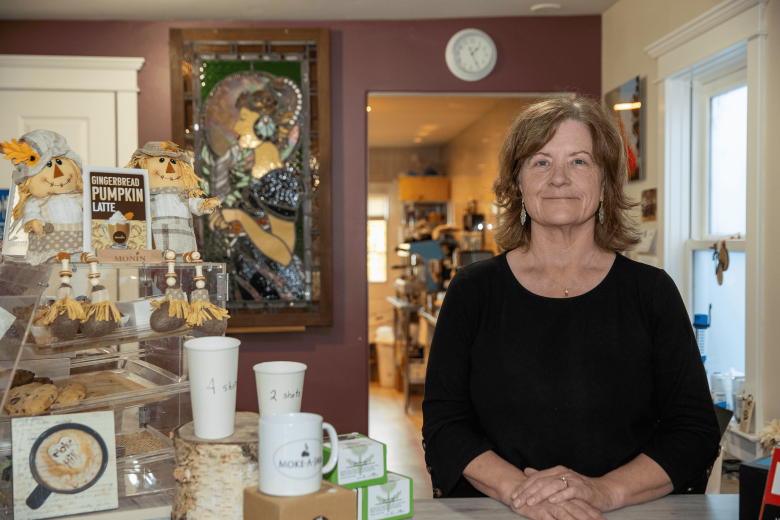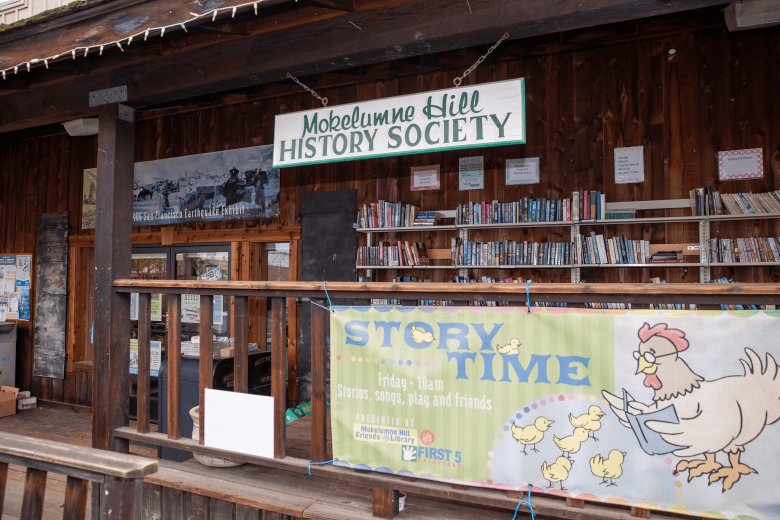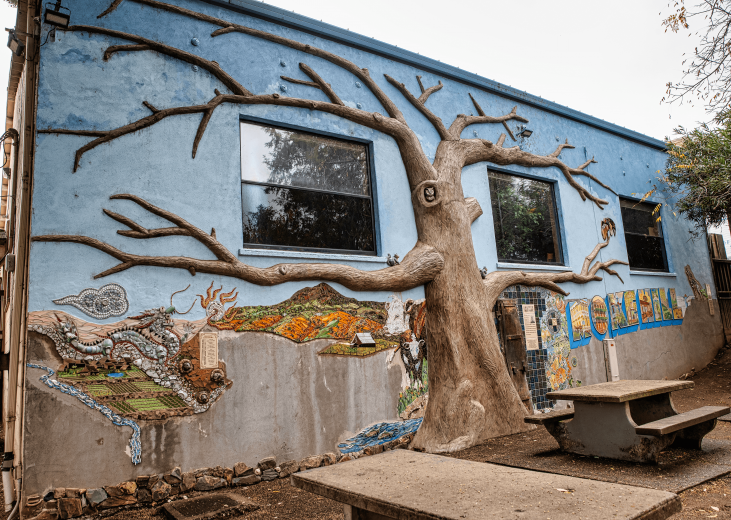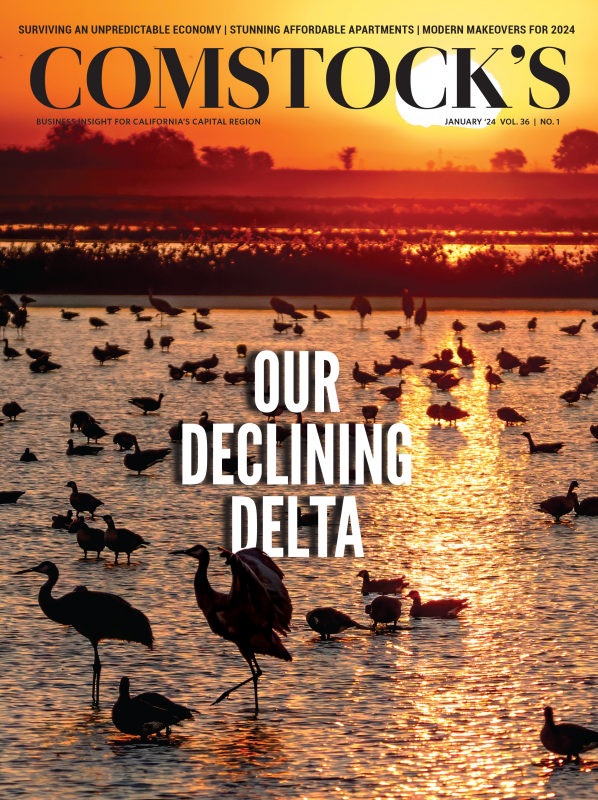Mokelumne Hill may not be the busiest tourist hub in the Amador-Calaveras Sierra Nevada foothills loop that includes Sutter Creek, Jackson, Angels Camp and Murphys. But that doesn’t mean the uniquely well-preserved 1850s Gold Rush-era settlement along the Mokelumne River, often called Moke Hill by the locals, is lacking in things to do and see.
With fewer than 700 residents, Mokelumne Hill — which is a designated California Historic Landmark — features a selection of restaurants, a library, a winery, saloons, art galleries and coffee shops along its Main Street core, as well as the legendary Hotel Léger, which recently came under new ownership. (Its 13 notoriously haunted rooms are currently being renovated.)
The former courthouse building was converted into the Hotel Léger
in 1875 and has remained the center of Mokelumne Hill’s social
scene since then.

The hotel is one of the longest continually operating in the
state. Its guest rooms are currently under renovation, but its
bar and restaurant remain open.

But the lure for history buffs is what you can experience for free within a several-block radius of the town just off Highways 49 and 26. The Historic Mokelumne Hill walking tour pamphlet, available through the Mokelumne Hill History Society, outlines an easy-to-follow map with a brief synopsis for 45 buildings to check out, many of which were originally built in the mid-1850s when the town swelled to 2,000 residents after the 1848 discovery of gold at Sutter’s Mill in nearby Coloma.
Today, Mokelumne Hill features a strong farming presence and still has many of its original downtown structures, says archeologist Julia Costello. Costello is an East Coast native who has traveled and worked all over the world but settled in Mokelumne Hill in the late 1970s after becoming one of the directors of an archaeology project working on the New Melones Dam on the Stanislaus River.
Mokelumne Hill town leaders Mary Jane Genochio and archeologist
Julia Costello tour Chinatown Gardens on Dec. 2.

The phone booth and sign are some of the items collected by Randy
Sparks, called by Julia Costello as “our most famous local
character.” Sparks, founder of the 1960s folk group New Christy
Minstrels and a longtime resident, imagined developing an
historic town he called Rooster Crossing, Costello says, and he
collected several items and antiques that have since
deteriorated.

“I loved the area and decided to stay after the project ended, eventually marrying a local of Mokelumne Hill,” says Costello, who is currently living a block off the town’s Main Street. “My travels and distant projects allowed me to come home to this tranquil home base.”
Costello, who formed Foothill Resources, Ltd., in 1983 with Judith Marvin, is one of the many dedicated Moke Hill residents working to preserve the town’s historic assets, whose population in the 1800s included French, Germans, Chinese, Mexicans and Chileans. Mokelumne Hill is the only town in Calaveras County with a historic design review district, she notes.
“For such a small town, we have huge community involvement,” Costello says, while showing off some of the sites on an early December morning along with local volunteer Mary Jane Genochio, who has served as the executive director for the Calaveras County Arts Council and as a board member of the Central Calaveras Fire and Rescue Protection District.
The Main Street core area is a mishmash of historic buildings, such as the Sturges Stone Store on E. Center Street, originally built in 1854, mixed in with businesses like the Moke Hill Nuts & Candies coffee shop, the Petroglyphe art gallery and the popular Renegade Winery restaurant.
The stone façade is all that remains of the L. Mayer Building
that was originally built in 1854, housing a barber shop and
restaurant at one time.

One of the oldest buildings in town is the Sturges Stone Store on
E. Center Street, originally built in 1854 as a two-story
structure. In 1945, a fire demolished the second story and some
of its stones were used to construct the present-day version,
which houses the Prospects Eco Art Center.

Town leaders tout the number of parks and preserved spaces, including baseball fields, a horse arena and Shutter Tree Park and its new mural. Chinatown Gardens, which earlier in 2023 was nominated to be included in the National Registry of Historic Places, was purchased last spring from the Mokelumne Hill History Society by the nonprofit Archaeological Conservancy, which left the site to local control.
“The Chinatown Gardens in Mokelumne Hill are the last remaining gardens of any Chinatown on the West Coast,” says Costello, adding that every Chinatown settlement would have a garden where they grew their own vegetables. Costello has been studying Chinatown Gardens since 2015, which includes the leftover remnants from the estimated 50 to 100 Chinese residents inhabiting the town from 1860 to 1880.
Moke Hill’s history is one carved by fire, with several over the years including an 1854 blaze that took out most of the town’s commercial district, says Michael Dell’Orto, chief of the town’s fire protection district. Some original remnants of structures still remain, including the stone façade for the L. Mayer Building on W. Center Street.
Some of the original terraced stone garden walls remain at
Mokelumne Hill’s Chinatown Gardens, which earlier in 2023 was
nominated to be included in the National Registry of Historic
Places. Every Chinatown during the Gold Rush era had similar
gardens to grow vegetables. It was purchased last spring from the
Mokelumne History Society by the non-profit Archaeological
Conservancy, which left the site to local control.

Shutter Tree Park, located just off Mokelumne Hill’s commercial
district, is the center of many of the town’s cultural events.
The park gets its name from an iron shutter that came from the
store of a Chinese store owner named Chung Kee, which closed in
1910.

Meanwhile, the Chinese Gardens’ water channel provided a fire break when the Butte Fire raced up the Mokelumne River canyon on Sept. 9, 2015, coming just a few feet from homes a block from Mokelumne Hill’s Main Street. The fire, however, burned Genochio’s home in Glencoe about six miles from Mokelumne Hill’s downtown. She decided to rebuild another home on Main Street under historic design review district regulations, keeping with the town’s Gold Country flavor.
“I’ve had people walk by and say ‘What a cute old home,’ and I said, ‘Well, it should be, it’s only 5 years old,’” Genochio says. “It looks old because we stayed within the design.”
Stay up to date on business in the Capital Region: Subscribe to the Comstock’s newsletter today.
Recommended For You
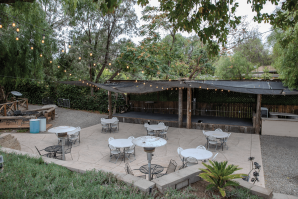
Mountain House Bar & Grill is in the Middle of Gold Rush History
The remote waypoint has served travelers for more than 170 years
It’s a stop for nightly commuters, a biker bar and a family-oriented historical highway landmark, hosting everything from car shows, weddings and baby showers, to taco Thursdays and Wednesday trivia nights.

Mounted Animals Draw Visitors to Iconic Foster’s Bighorn for 90 Years
Rio Vista restaurant and bar features hunting trophies from around the world
Bud Milo enters the 90-year-old restaurant and bar on Main Street in Rio Vista for the first time, and his expression immediately changes after seeing 300 mounted hunting trophies and photos lining the walls. “There’s a whole lot of animals here,” says the incredulous Milo.
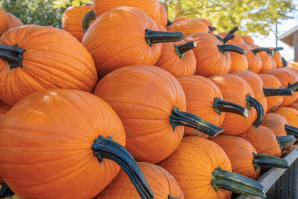
Family Fun at Bishop’s Pumpkin Farm in Wheatland
Three generations have run the popular attraction for more than 50 years
Wayne Bishop of Bishop’s Pumpkin Farm in Wheatland claims the farm is the largest pick-your-own pumpkin patch in the world. It remains a true family-run business, with Wayne, his wife Ann, his sons Lee and Austin, and his daughter-in-law Courtney leading the farm his parents started more than 50 years ago.
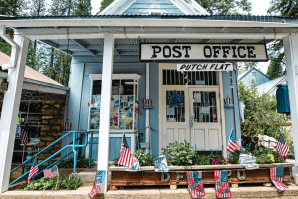
Dutch Flat Is a Trip Into California’s Gold Rush
Visitors find historic charm in the mountain community of just 133 residents
The well-preserved, semi-ghost Placer County town of Dutch Flat, an hour drive east of Sacramento in the Sierra Nevada foothills, has earned the description of being “a step back in time,” as local hotelier Leif Lowery described it.

Up, Up and Away With Yolo Ballooning Adventures
Enjoy a thrilling ride in the sky
As the crew with Yolo Ballooning Adventures prepares the aircraft for its scheduled 90-minute trip, general manager Mike Veliz looks out over the launch site dotted with half a dozen other balloons from various Northern California companies readying for takeoff. “The best part of this job,” says Veliz, a Woodland native, “is getting to watch the sunrise every day.”




